
1952 Steel Strike
Striking America
By Richard E. Noble
On April 9, 1952 the United Steelworkers of America planned to walk out on strike against U.S. Steel and nine other steel makers. But on April 8 President Harry Truman had ordered his Secretary of Commerce, Henry A. Wallace, to seize most of the Country’s steel mills. Truman’s argument for this action was the protection of the nation’s security.
This was really nothing new. During World War I the government had nationalized the railroads, the telegraph lines, and the Smith & Wesson Company. Then again in World War II the government had nationalized the railroads, the coal mines, the midwest trucking operators and others. And in April of 1945 and in August of 1946 Harry had seized twenty-eight industrial properties - sometimes entire industries, the railroads and meat packers for example. But Harry Truman was no FDR or Woodrow Wilson for that matter. And the Korean War was no World War I or World War II.
By 1952 neither Harry nor his political party was all that popular. On February 9, 1950 McCarthy denounced the Truman administration on the grounds that they were allowing known communist to run free through the corridors of Washington. But also in 1950 North Korea invaded South Korea and the Korean “Police Action” followed.
On September 8, 1950 the Congress passed the Defense Production Act. This gave the president the power to requisition any facilities, property, equipment, supplies, component parts or raw materials for the nation’s defense. The bill also gave the president the power to enact wage and price controls. None of this was new. This was all wartime procedure. But this was Truman’s war not FDR’s or Wilson’s. And was it even a “real” war?
The steel owners sued. The steel mills involved included Armco Steel, Bethlehem Steel, Great Lakes Steel Corporation, Inland Steel, Jones and Laughlin Steel, Republic Steel, Sharon Steel, U.S. Steel Wheeling Steel and Youngstown Sheet and Tube and numerous small manufacturers.
Even though a few years earlier Harry had threatened to draft all the striking railroad workers, after he had nationalized the railroads successfully, on this occasion he was in total agreement with the workers. On April 8, 1952 he made a radio broadcast from the White House. He told the American people that the steel industry could not be allowed to shut down. “It is vital to the defense effort. It is vital to peace ... We do not have a stockpile of the kinds of steel we need for defense. Steel is flowing directly from the plants to our soldiers at the front in Korea ... If steel production stops it won’t be long before we have to stop making engines for the Air Force planes ... A prolonged shutdown would bring defense production to a halt and throw our domestic economy into chaos.” He went on to inform the public that he was taking over the steel mills and demanding the mill owners and representatives of the mill workers meet in Washington immediately and settle this dispute with the government’s arbitrators.
He explained about the wage and price controls that had been put in place to counter inflation. “The union has accepted these rules. The companies have not accepted them ... On November 1, 1951 the union gave notice that in view of the higher cost of living and the wage increases already received by workers in other industries, the steel workers wanted higher wages and better working conditions in their new contract for 1952 ... The steel companies meet with the union but the companies never really bargained ... They said there should be no changes in wages and working conditions - in spite of the fact that there had been substantial changes in many other industries and in spite of the fact that the steel industry is making very high profits ... About three weeks ago on March 20, the wage board recommended certain wage increases and certain changes in working conditions ... The Wage Board’s recommendations were less than the union thought they ought to have. Nevertheless, the union accepted them as a basis for settlement ... When you look into the matter, you find that the Wage Board’s recommendations were fair and reasonable ... The steel workers have had no adjustment in their wages since December 1, 1950. Since that time the cost of living has risen, and workers in such industries as automobiles, rubber, electrical equipment, and meat packing have received increases ranging from 13 to 17 cents an hour ... the steel industry has been lagging behind in these matters, and the improvements suggested by the Board are moderate.”
Truman went on and on in defense of the union’s actions but owners still resisted. So Harry nationalized the steel industry. The Supreme Court sided with the mill owners and against the president nevertheless - Youngstown Sheet & Tube co. v. Sawyer, 343 U.S. 579 (1952).
The union went on strike and the strike lasted 53 days and ended on July 24, 1952.
The steel mill owners it seems were happy to get their mills back and consequently they settled with the union. The union got pretty much what they had asked for, four month earlier.





































